
The P-51
Peripheral 8051
System on a Chip
www.ControlChips.com
|
Cybernetic Micro Systems • PO Box 3000 •
San Gregorio CA 94074 |
P R E L I M I N A R Y
For two decades the 8051 microprocessor/computer has served as the standalone solution to countless embedded system applications. The flexibility, power, and familiarity of the 8051 are such that 8051 knowledge is in almost every designer's tool kit. A major weakness of the '51 is its interface to a host processor, typically either UART-based or parallel handshake. Because these typically mismatch the speed of the host, the Cybernetics P-51 provides a novel tightly coupled architecture for adding the power of the 8051 to a host processor.
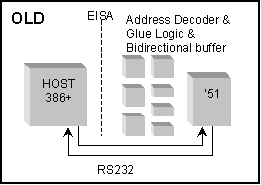
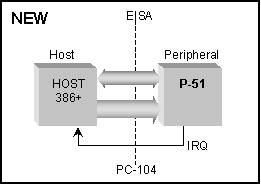
The figures above illustrate how the P-51 peripheral 8051 interfaces directly to an ISA-bus, PC-104, or equivalent, instead of requiring 10 to 20 glue chips, as does an 8051 processor.
The P-51 Peripheral-8051 Architecture
Why P-51? First the name. As most engineers know, the P-51 was the fastest propeller driven fighter in WW-II, achieving 451 MPH in level flight, and exhibiting a graceful beauty and a deadly effectiveness. In honor of this marvelous design we have chosen the P-51 logo:
The P-51 name is a reminder that this device is a Peripheral 8051 processor, not a standalone 8051 processor. Most engineers have a clear image of the 8051 CPU, so the name P-51 focuses on the unique aspect of the P-51:
A peripheral 8051 requires a host to which it is peripheral.
This important difference is key to understanding the P-51 architecture, below:

The P-51 Host Bus Interface
The P-51 is a peripheral processor, and thus serves as a peripheral to a host processor. Because most of the ports, instruction set, I/O hardware, etc., are identical to the 8052 micro controller, most engineers need only understand the new host bus interface to begin using the device.
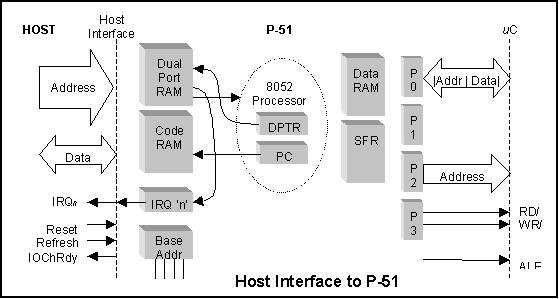
Figure 2. The host interface provides host access to Dual Port RAM and Code RAM and allows the P-51 to interrupt the host using IRQs.
As shown in the figure above, the host processor can access the P-51's Code RAM and Dual Port RAM via a simple ISA bus compatible interface. The host provides a 20-bit address and 8-bit bi-directional data bus to the P-51. The P-51 supports the EISA REFRESH & IOCHRDY and provides a user selectable IRQ output.
P-51 Pinout Diagram
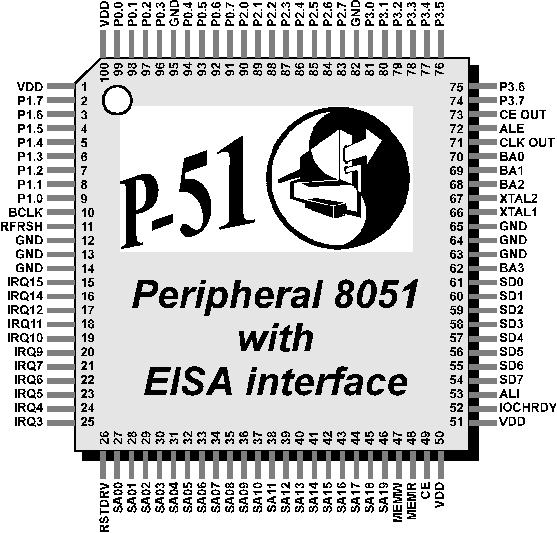
P-51 Pin List
|
Pin Name |
Pin # |
Type |
Description |
|
Vdd |
1, 50, 51, 100 |
P |
3.3 Volt Power Supply |
|
Gnd |
12, 13, 14, 63, 64, 65, 82, 95 |
P |
Ground |
|
P0.0 - P0.7 |
99, 98, 97, 96, 94, 93, 92, 91 |
I/O |
8051 Port 0 (Multiplexed Data Bus and Lower Address Byte) |
|
P1.0 - P1.7 |
9, 8, 7, 6, 5, 4, 3, 2 |
I/O |
8051 Port 1 (General I/O) |
|
P2.0 - P2.7 |
90, 89, 88, 87, 86, 85, 84, 83 |
I/O |
8051 Port 2 (General I/O and Upper Address Byte) |
|
P3.0 - P3.7 |
81, 80, 79, 78, 77, 76, 75, 74 |
I/O |
8051 Port 3 (General I/O and Special Controls) |
|
BClk |
10 |
I |
ISA Bus Clock, normally 8.33 MHz |
|
RFrsh |
11 |
I |
ISA Refresh, low during a refresh cycle, high during a normal cycle * |
|
IRQ3 - IRQ15 |
25, 24, 23, 22, 21, 20, 19, 18, 17, 16, 15 |
O |
ISA Interrupt Request signals, open
drain. |
|
RstDrv |
26 |
I |
ISA Reset Drive, high during system reset |
|
SA0 - SA19 |
27, 28, 29, 30, 31, 32, 33, 34, 35, 36, 37, 38, 39, 40, 41, 42, 43, 44, 45, 46 |
I |
ISA Address Bus |
|
MemW |
47 |
I |
ISA Memory Write strobe |
|
MemR |
48 |
I |
ISA Memory Read strobe |
|
CE |
49 |
I |
Chip Enable, low during ISA Read/Write cycles, may be tied low |
|
IOChRdy |
52 |
O |
ISA I/O Channel Ready, open drain, low to extend an ISA cycle |
|
ALI |
53 |
I |
Address Latch Input, high if SA0 to SA7 are valid as address signals, low to latch SA0 to SA7 for multiplexed Address/Data bus (non-ISA) |
|
SD0 - SD7 |
61, 60, 59, 58, 57, 56, 55, 54 |
I/O |
ISA Data Bus |
|
BA0 - BA3 |
70, 69, 68, 62 |
I |
Base Address jumper inputs |
|
XTAL1 |
66 |
I |
Crystal Oscillator circuit input, also external oscillator module input |
|
XTAL2 |
67 |
I |
Crystal Oscillator circuit input, no connect for oscillator module |
|
Clk Out |
71 |
O |
Clock Out, P-51 oscillator circuit output clock |
|
ALE |
72 |
O |
8051 Address Latch Enable output |
|
CE Out |
73 |
O |
Chip Enable Output, when low, all movx instructions access external memory or devices (inverse of P1.6 signal) |
P-51 Code RAM
Because its operation is simplest, we discuss the P-51 Code RAM first.
As a peripheral device, the P-51 expects to be reset by the host, via a signal such as the (E)ISA RESETDRV signal, which resets all devices at startup. While the P-51 can be placed in reset via this hardware strobe, the P-51 will remain in the reset state until released via a software operation, as described below. During the period while the P-51 is held in RESET:
the host has access to the P-51 Code RAM.
This is a key fact of the P-51 operation, so we repeat it.
While the P-51 is RESET, the host processor can write into the P-51's Code RAM. When released from RESET, the P-51 executes from location 0 in Code RAM!
This is the most significant difference between a "standalone" 8051/52 and the "peripheral" P-51. Standalone devices store code in non-volatile memory such as EPROM, ROM, FLASH, etc. Peripheral devices store code in volatile memory, therefore a host, or an Internet-connected device, can supply code to the P-51.
The host can access the P-51's code memory only while the P-51 is RESET.
When the P-51 executes from Code RAM, the host is locked out of Code RAM.
(The host can reset the P-51 at any time and regain access to Code RAM.)
Because most users are familiar with the 8051, and understand its "standalone" capability (and limitation) we emphasize (still again) the differences in operation:
The host downloads code to the P-51's Code RAM while the P-51 is RESET. When the P-51 is released from reset, it "wakes up" and immediately begins executing the downloaded code from location zero.
The Reset Control Register of the P-51
The P-51 possesses a host accessible control register that is mapped into dual-port RAM address space as described below. This control register allows the host to bring the P-51 in and out of reset via software, as well as driving the P-51 into the reset state via the reset pin, RSTDRV, on the P-51.
P-51 Reset Behavior
|
RESET |
The P-51 is reset when the reset pin, RSTDRV, is driven high, and remains in reset when the RSTDRV pin returns low. |
|
RESET |
The P-51 is reset when the least significant bit of the control register is cleared to '0' and released from reset when this bit is set to '1'. |
|
|
|
The multiple address spaces probably represent the most complex aspect of the 8051, and the P-51 is slightly more complex. The basic 8051 address spaces are relative only to the 8051, while a subset of the P-51 address spaces are also relative to the host. Although each address space effectively starts at location/ address zero from the 8051 perspective, the address as seen by the host is more complicated. The complication comes from a base address register whose contents are pin selectable (and software selectable) that is, the base address can be specified via four pins, connected through jumpers to ground or VCC. The high bits of the host address bus are compared to these pins. If they match, the P-51 is chip selected by the host, and its relevant address spaces become accessible to the host. Thus the P-51 can be mapped into the address space of an IBM-PC class computer and can function as truly "intelligent memory".
P-51 Address Space
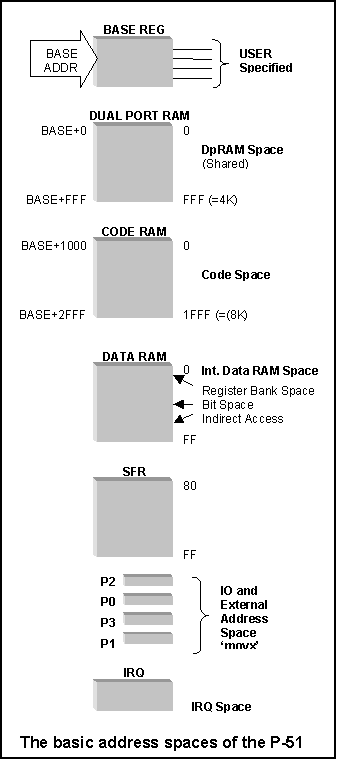
As shown in this figure:
Dual port RAM is at
BASE + 0.
Code RAM is at
BASE + 0x1000
(= BASE + 4096).
For example, if BASE is set to 0x0D (= 1101) then the base address is set to 0xE4 = 11100100 which corresponds to segment 0xE400 in an 80x86 (Real mode) segment register. The net effect is to set the six most significant bits from the appropriate base address value in the Base Table as the active Base Address. These six bits are compared to the six most significant bits of the 20-bit address applied by the host to the P-51. When these six address bits match, the P-51 is selected, else the P-51 is de-selected, and no access to P-51 Address space is available to the host.
|
|
Base Address Switch Settings
|
Switch |
Segment |
|
|
All Closed: |
0000 |
00 |
|
|
0001 |
A4 |
|
|
0010 |
A8 |
|
|
0011 |
AC |
|
|
0100 |
B0 |
|
|
0101 |
B4 |
|
|
0110 |
C8 |
|
|
0111 |
CC |
|
|
1000 |
D0 |
|
|
1001 |
D4 |
|
|
1010 |
D8 |
|
|
1011 |
DC |
|
|
1100 |
E0 |
|
|
1101 |
E4 |
|
|
1110 |
E8 |
|
All Open |
1111 |
EC |
We consider three example cases in detail:
|
Jumper |
Base Address |
Host Address to select P-51 Base |
|
0000 |
000000 |
0000 0000 0000 0000 0000 |
|
1010 |
110110 |
1101 1000 0000 0000 0000 |
|
0101 |
101101 |
1011 0100 0000 0000 0000 |
The first case is the "default base" in which both the P-51 and the host addresses begin at zero. While this may be appropriate for many embedded applications, it is typically inappropriate for IBM-PC type applications, in which address zero for the PC is dedicated to other functions.
In the case in which the Base address is set to '0101', the six base address bits are '101100' which corresponds to a host address: 1011 0100 0000 0000 0000. When the host addresses 0xB4000 the Base address of the P-51 is selected.
Code RAM Access
Assume that the P-51 is attached to an (E)ISA-bus and that it's Base address jumpers are set to '1010'. As can be read from the Base Address Table above, this selects a Base address of 0xD8000 for the P-51 as seen by the host. Since Code RAM is at Base + 0x1000, to access the first byte of Code RAM, the host must put address D9000 = D8000 + 1000 = 1101_1001_0000_0000_0000.
To access the second byte of Code RAM the host must put (hex) address 0xD9001 = 1101_1001_0000_0000_0001 on the 20 bit P-51 host address bus.
Using these addresses, the host can write 8051 binary opcodes into Code RAM that will be executed by the P-51 when the P-51 is released from RESET. From the P-51's perspective, the first byte of Code RAM is at location/address zero.
Host Access to the Dual Port RAM
As discussed above, address zero in the P-51 Code RAM is offset (hex) into host address space by BASE + 0x1000. Thus Code read from location 0x100, as seen by the P-51 program counter, will be written into BASE + 0x1000 + 0x100, as seen by the host.
If this is understood, then access to the Dual Port RAM shared memory space is simple. The first byte of dual port RAM is at the BASE address as seen by the host and at address zero of Data Memory as seen by the P-51:
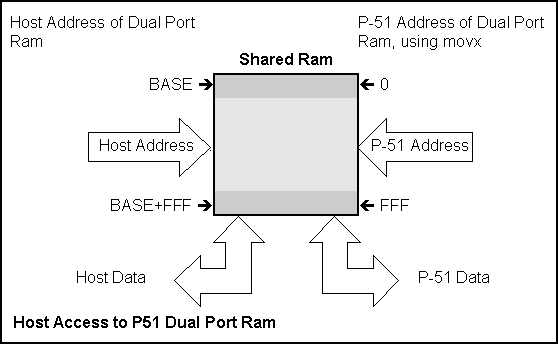
Note that, unlike Code RAM, which is accessible only when the P-51 is RESET and the BASE address + 1000 is presented to the P-51, the dual port RAM is accessible by the host whenever the BASE address is presented to the P-51.
Chip Enable and Read/Write strobes:
Although the host must present an address that matches the BASE address set into the BASE address latch, the P-51 does not actually allow access to dual port RAM (or Code RAM) unless the Chip Enable pin (#49) is asserted low and a read or write strobe is presented to the P-51.
Special Control Registers in Shared Memory Space:
Now that we know how to access shared memory space from the host, we can understand how to access several control registers mapped into dual port RAM space. Specifically, the first four addresses in shared memory space access control registers, as well as dual port RAM. Thus, when the host writes to address BASE + 0, BASE + 1, BASE + 2 or BASE + 3, the control registers are addressed (and data is also written into dual port RAM). Similarly, the last two addresses in dual port RAM space are mapped by special registers:
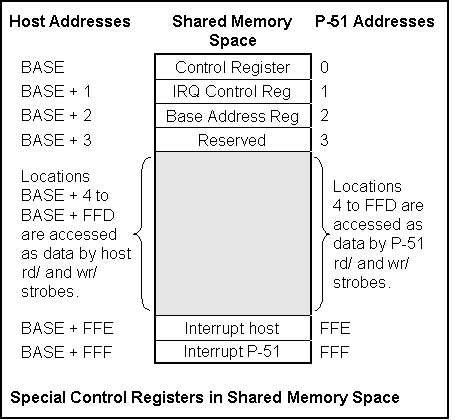
The control registers at BASE to BASE + 3 are write-only, and can only be written by the host. If the P-51 writes to these locations, it only writes into the dual port RAM, not into the control registers. A read of these location returns the last data written into the dual port RAM.
Control Register Detail

The P-51 Control Register is the "master" control that causes the P-51 to be held in the RESET state or to RUN programs from Code RAM. If zero is written to this register the P-51 is reset and remains reset while CR.0 = 0. If access to Code RAM is desired, then CR.4 must be set to 1. Although CR.4 may be zero for manufacturing test of the P-51, all user operations, either downloading code while reset or executing code while running, require CR.4 = 1.
CR.3 is an IRQ-enable bit that can disable interrupts from the P-51 to the host. For example, if the host is not prepared to service interrupts from the P-51 then CR.3 should be set to zero. To allow P-51 interrupts set bit CR.3 to one.
CR.1 and CR.2 control register bits are mapped into Port 1 bit 1 and Port 1 bit 2, that is, a P-51 can read CR.1 on P1.1 and CR.2 on P1.2. These user definable bits allow for example, the user to specify two "mode bits" that the P-51 software can test while executing. There are no preferred values for these bits as their value and their meanings are completely user defined. Debug Bits CR.5, CR.6 and CR.7 are defined in a later section, and should usually be set to zero.
Note that the Control Register does not allow individual bit access. That is, all eight bits must be written at once. Therefore, the values written to the control register must set or reset the desired bit while preserving the remaining bits.
For example, to reset the P-51 and then download code to address N of the Code RAM (at host address BASE + 0x1000 + N) the user/host should write 0001 0000 (0x10) to the Control Register which is located at BASE address. After the download is finished, the user can write 0001 0001 (0x11) to release the P-51 from RESET (but with interrupts inhibited) or write 0001 1001 (0x19) to release the P-51 to execute and to enable the IRQ output to the host.
The IRQ Control Register:
As may be seen from the pinout diagram -- the P-51 supports numerous IRQ output pins (IRQ-3 to IRQ-15) covering most of the IBM-PC IRQ pins of the EISA bus. These are open collector outputs that are typically pulled up to 5 volts but can be driven low to interrupt the host. Because IRQs are a scarce resource, only one is used by the P-51 and is selected by the host via the IRQ Control Register, mapped into location BASE +1 of the host address space.

The low nibble is set to the desired IRQ#, for example, 0101 selects IRQ-5 while 1111 selects IRQ-15, etc. Bit G (= IRQ.4) is the Interrupt GATE which enables or disables the IRQ (in combination with Control Register bit CR.3). The most significant bits of the IRQ Control Register must be set to zero.
Shared Memory Interrupt Locations:
Although the IRQ control gate determines which IRQ output will be used to interrupt the host, the actual interrupt mechanism is associated with the INTERRUPT Register at address BASE + 0xFFE (host perspective) or equivalent address 0xFFE (P-51 perspective). When the P-51 writes to address 0xFFE in shared memory space, an interrupt is generated and sent to the host on IRQ #N if the IRQ control register contains 0001 N and the Control Register = 0001 1xx1. The host is assumed to contain an appropriate ISR (Interrupt Service Routine) which will read the interrupt register at (BASE + 0xFFE) and will interpret the value read from this location. The interrupt appearing on IRQ #N is a low going pulse. When this pulse has been generated (by the P-51 writing to 0xFFE), all further interrupt pulses to the host are inhibited until the host reads the (BASE +) 0xFFE location. After the host reads this location another interrupt can be generated by the P-51, since the "lock" is removed by the read. However a P-51 program does not "know" that the interrupt has been cleared, therefore the appropriate protocol is as follows:
P-51 Protocol to interrupt the host:
To summarize, the host must setup the IRQ Control Register and the Master Control Register to allow interrupts to the host on a specified IRQ-pin. Once this has been done, the P-51 can interrupt the host by writing any (non-zero) value into address 0xFFE in shared RAM space, causing the selected IRQ-pin to pulse low. The host should respond to this IRQ pulse by reading the value of location ( BASE + ) 0xFFE and interpreting the value (the interpretation is by a pre-agreed convention between P-51 program and host). When the host has finished and is able and willing to accept more interrupts the host writes zero to (BASE +) 0xFFE to signal READY to the P-51. The P-51 should test location 0xFFE for zero before writing a value to this address. If the value is non-zero, the P-51 should wait for the value to become zero before writing a non-zero interrupt value to 0xFFE.
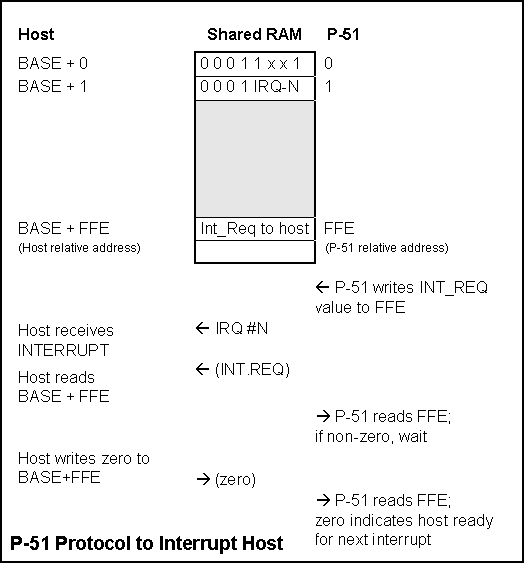
Host Software Interrupt of P-51
The above description details how the P-51 software can generate interrupts to the host via an IRQ pin. The converse operation allows the host software to interrupt the P-51 by writing to location (BASE+) 0xFFF. This write will generate an interrupt on P-51 Port 3 Pin 3 (P3.3) which vectors through 8051 External Interrupt 1 location 0x13 (hex) in P-51 Code RAM. The interrupt will cause P3.3 to go low and remain low until the P-51 reads location 0xFFF in shared space (dual port RAM). The act of reading 0xFFF (from the P-51 side) clears the interrupt and P3.3 returns hi. The P-51 can interpret the value read from 0xFFF to decide what action is being requested. Finally the P-51 can write zero to 0xFFF, signifying to the host that the P-51 is ready to accept further interrupts.
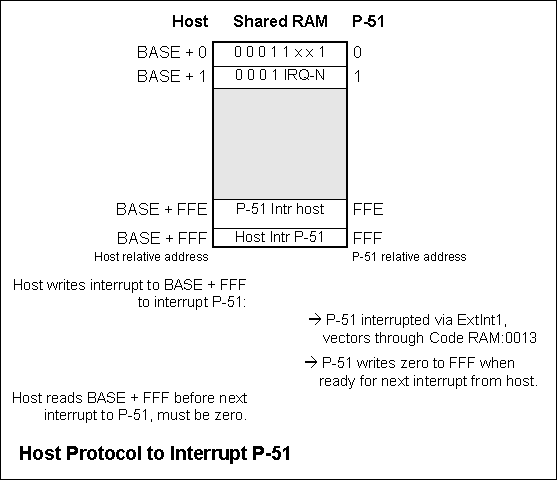
Summary of Software Controlled Interrupts:
The Software Interrupts are symmetrical and are supported by P-51 hardware and extended by software protocols.
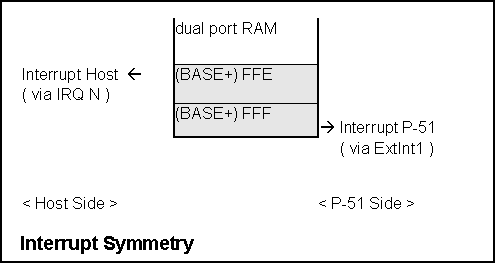
The hardware support allows the interrupts to write to a location and thereby generate an interrupt to the "other side". If the other side writes to the same location there is no effect except to write a value into memory, however if the other side reads the same location, then the effect is to clear the interrupts. When the interrupting side reads the same location, there is no effect:
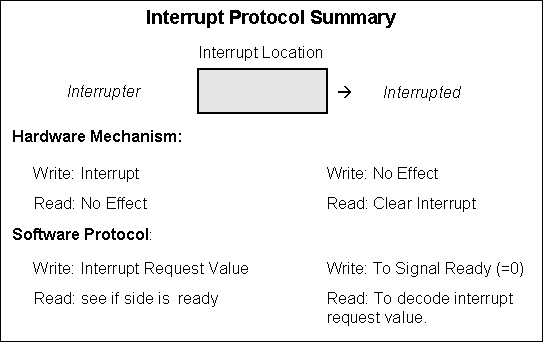
P-51 Access to Code RAM
When the P-51 is released from reset (the Control Reg must contain 0001 xxx1) its Program Counter (PC) is set to zero. This causes the P-51 to fetch the first byte from Code RAM and begin executing code. (Normally the first instruction is a "jump over vectors"). During execution, the P-51 fetches all instructions from Code RAM using the Program Counter. The P-51 has only one access mechanism to Code RAM. The 8051 "movc a,@a + Dptr" allows the P-51 to use a value in the accumulator as an index into a table that Dptr points to, and read from the table into the accumulator. There is no other P-51 access to Code RAM.
Host Access to Code RAM:
The host processor can, while the P-51 is held in Reset, access Code RAM at locations BASE + 0x1000 to BASE + 0x2FFF, using normal read and write operations from the EISA-bus side of Code RAM. There is no other host access to Code RAM.
P-51 Access to Dual Port RAM:
The P-51 uses the 8051 "movx" instruction to access its own internal dual port RAM. Those familiar with the 8051 will remember that "movx" is normally used in conjunction with P2 and P0 to access external memory or devices outside the 8051. This is still the case in the P-51, however it is complicated by the existence of the integral dual port RAM. The solution is as follows:
The P-51 I/O pin port 1.6 is used to select between dual port RAM and an external memory or device. When P1.6 is set (as it is by 'RESET') then the P-51 "movx" instructions address external memory (via the "CE-out" pin 73). When P1.6 is cleared, as it is by the "clr P1.6" instruction, then "CE-out" is disabled (i.e., goes to '1') and the internal dual port RAM is enabled. When dual port RAM is enabled, all "movx" operations operate on dual port RAM. These include:
|
movx a, @ RN |
; read thru P2:(Rn) |
|
movx a, @ Dptr |
; read thru (Dptr) |
|
movx @ Rn, a |
; write thru P2:(Rn) |
|
movx @ Dptr, a |
; write thru (Dptr) |
Movx Latch
The "movx" instructions in the P51 are identical to the "movx" instructions in the 8051, with respect to the read and write signals, P3.6 and P3.7, and to address and data on P2 and P0. This is true whether the target of the "movx" is internal or external; that is, whether the P51 is accessing the internal dual port RAM or an external RAM/IO-device.
A consequence of this is that systems that use only internal dual port RAM will still see P2:P0 changes (and P3.6,P3.7) when "movx" occurs. If these ports are intended to drive external devices, then latches may be required on P2 and P0 to shield the external devices from "movx" induced changes.
Similarly, if external RAM-I/O is used, the external RAM must be disabled during internal "movx" operations. This will normally be done using P1.6 as chip select.
P-51 Dual Data Pointers:
The P-51 possesses two 16-bit Data Pointers instead of the single 16-bit Dptr of the standard 8051. These data pointers are accessed 'one at a time' and are selected by setting or clearing a bit in a special function register, as follows.
The Auxiliary Data Pointer control register exists in Special Function Register space at address 0xA2. The least significant bit, b0, of this register controls which data pointer is in use. The data pointers are identical in behavior, although the second data pointer is only accessible when selected and has no separate SFR location. Their utility lies in the ability to pre-load both data pointers, then switch between them by toggling the selection bit in the special function registers. This precludes the need, with only a single data pointer, to point to a first location, then save the address, point to a second location, etc. An example of the use of two data pointers to move data from a source buffer to a destination buffer is shown below.
|
; CONSTANTS: |
|
|
|
|
SRC_buffer = 0x400 |
; location of source bytes |
|
|
DST_buffer = 0x500 |
; location of destination buffer |
|
|
buf_length = 0x40 |
; number of bytes to move |
|
|
DP_sel data 0xA2 |
; Special function register |
|
; CODE: |
|
|
|
|
; |
|
|
|
mov Dptr, # SRC_buffer |
; setup source pointer |
|
|
inc DP_sel |
; switch data pointers |
|
|
mov Dptr, # DST_buffer |
; setup destination ptr |
|
|
mov r0, # buf_length |
|
|
Copy_Loop: |
|
|
|
|
; |
|
|
|
inc DP_sel |
; switch to source pointer |
|
|
movx a, @ Dptr |
; get source byte |
|
|
inc Dptr |
; next source location |
|
|
inc DP_sel |
; switch to dest. Pointer |
|
|
movx @ Dptr, a |
; put byte into dest buf. |
|
|
Inc Dptr |
; next destination location |
|
|
; |
|
|
|
djnz r0, Copy_Loop |
; repeat til done... |
|
|
; |
; fall thru with Dptr -> destination |
|
|
... |
|
P-51 SQRT function
The P-51 possesses a Square Root function that takes a 16-bit value and returns an 8-bit square root. This function does not exist on any other 8051, so we describe its operation below:
The P-51 SQRT operation utilizes special locations in the Special Function Register address space. The 16-bit value is written into two of these locations and the 8-bit square root is read from a third. The square root is computed in one instruction cycle, so that the answer may be read as soon as the value has been loaded. The Special Function Register locations involved are shown below:
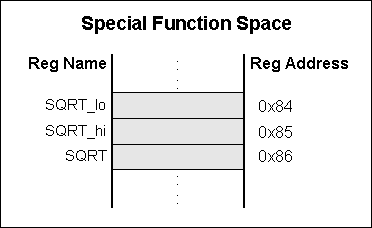
The code fragment below illustrates the use the SQRT function:
|
SQRT_lo |
data 0x84 |
|
SQRT_hi |
data 0x85 |
|
SQRT |
data 0x86 |
|
|
|
|
mov a, # 4 |
; get hi-byte |
|
mov SQRT_hi, a |
; write hi-byte |
|
mov SQRT_lo, # 0 |
; write lo-byte |
|
mov a, SQRT |
; read answer |
Note that the data can be loaded directly as an immediate (constant) value or can be loaded from the accumulator, allowing variable data to picked up from memory and loaded into the square root circuits. The answer can be read from the SQRT register into the accumulator, then used as appropriate. Any direct moves to and from the SQRT registers can be used.
"Debug" Features of the P-51
The classical 8051 does not support debugging with either breakpoints or single step capability. Instead, special "bond out" versions of the chips are packaged by specialist companies and sold as "ICE", (In-Circuit-Emulation) tools, typically for thousands of dollars. The ICE is controlled by a host connected by an umbilical cord to the 8051 bond-out chip that is plugged into the system.
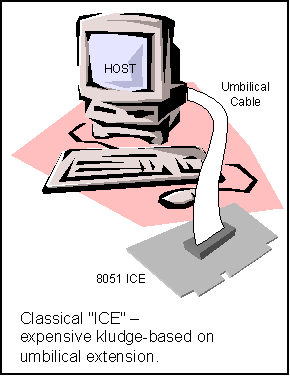
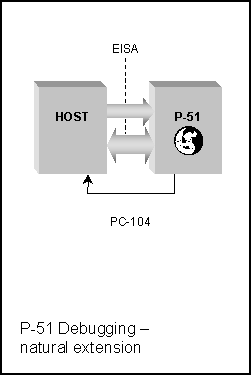
P-51 Debug Support
The P-51 offers these features that support debugging 8051 software. None of these features is available on standard 8051s.
- Breakpoint operation
- Single-step operation
Each of these features allows the user, via the host processor, to detect P-51 code execution or data access details that are useful in debugging software. All these features are patented or patent pending.
P-51 Breakpoint Processing
The 8051 has an undefined opcode, 0xA5, that has been defined as a breakpoint instruction in the P-51. When the P-51 encounters a breakpoint instruction it copies the address or location of the breakpoint into a mailbox in dual-port RAM, then decrements the program counter and pushes it onto the stack, and then sets the P-51 program counter to an address in high code RAM address space, issues an interrupt (0x2E) to the host via IRQ, and "freezes".
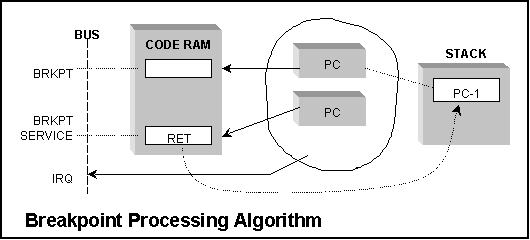
Typical Breakpoint Usage
Breakpoints break the flow of execution at a particular point in address space, then typically turn control over to the user. A breakpoint is typically used to determine whether (or when) the 8051-code execution follows a path including the breakpoint. If multiple paths are possible, multiple breakpoints can be used. Breakpoint operation typically requires some level of intervention, or cooperation, on the part of the user. The P-51 allows the user to specify what actions are to occur when a breakpoint event occurs. At a minimum, the host must replace the breakpoint with a "NOP" or must restore the original instruction that was previously "overwritten" by the breakpoint. The P-51 must also write at least a "return" opcode into the Breakpoint service routine in Code RAM. The P-51 can optionally write almost any breakpoint service code (terminated with a "return"). In this manner the P-51 can access resources, such as data RAM contents, port I/O, accumulator, PSW, timer, contents, or any other location or data accessible by the P-51. These resources can be copied into dual port RAM locations by the P-51, where the host can access them (and the user can display them, etc.). Finally, the return code at the end of the breakpoint service is encountered, and the address of the breakpoint is popped from the stack into the P-51 program counter register. Remember that the PC was decremented before being pushed on the stack, so the P-51 tries to execute the instruction at the breakpoint address again! If the breakpoint has been replaced by a "NOP" or by the original (pre-breakpoint) opcode, then execution will continue normally from this location.
Summary of breakpoint operations required of the user:
PRE-BREAKPOINT:
- Determine location in Code RAM to place breakpoint.
- "Save" instruction at this code location.
- Write breakpoint into code location.
- Release P-51 from RESET.
-
P-51 runs until breakpoint
executed.
POST-BREAKPOINT:
- Host reads breakpoint address from dual port RAM mailbox (0xFFB, 0xFFC).
- Host identifies "original" instruction at this address.
- Host writes original instruction back into Code RAM.
- Host writes breakpoint service routine plus "return" into high location in Code RAM. (Base + 0x1E2F => P-51 Code Address 0x0E2F)
- Host releases the P-51 to execute breakpoint service by clearing the Wait flag. The Wait flag is bit 6 of the Control Register.
- After the Wait flag is cleared, the P-51 will execute the code from address 0x0E2F until a return instruction is encountered. The P-51 returns to the location at which the breakpoint was originally detected, which now holds the original instruction (as per step 8).
- The Host can access data (if any) placed in dual port RAM by breakpoint service processing.
- Host options using "single step" may be employed.
The 2E2F breakpoint address: When a breakpoint occurs, the P51 indicates that the next instruction will be at 2E2F. Since the current version P51 has only 8K of RAM, 2E2F is outside of the address space, and execution actually occurs at 0E2F, ignoring the highest bit. Note that if you actually use 2E2F, the P51 will work, ignoring the msbit and using 0E2Fh.
P-51 Single-Step Processing
Breakpoints are 'stealthy' in that they lie unnoticed unless and until they are encountered during the course of execution. Associated with this is the need to place the breakpoint opcode in the code space while the host has control of the Code RAM, that is, while the P-51 is RESET. If the host has not placed any break-points in Code RAM, this feature is not available during the period of execution. The host can always access Code RAM by setting the Reset bit, b0, in the Control register, but this will cause the P-51 to begin execution again, therefore it is not generally possible to add breakpoints to Code RAM after execution has begun.
The P-51 Single Step capability, on the other hand, allows the host to take control of the P51 while the P-51 is executing code, with no prior preparation required. This very useful feature is described below.
The P-51 Single Step is controlled by bit b7 of the Master Control Register, which is located at BASE address as seen by the host. This bit is normally set to '0' when the P-51 is released from RESET. Because this Control register is mapped into shared memory space, it is accessible at all times, including while the P-51 is executing code. Thus the Single Step bit can be set to '1' during P-51 execution. (Remember that the Control Register is byte accessible, not bit accessible, so it is necessary to preserve all of the other bits of the Control Register when setting the Single Step bit to one.) The P-51 actually tests the state of the Single Step bit at then end of every instruction fetch, proceeding as usual if the bit is zero. When the Single Step flag is set to one, the P-51 will enter the Single Step mode as follows:
The P-51, upon detecting the Single Step flag, writes the current value of the Program Counter into the same mailbox used by the Breakpoint instruction, that is, into location 0xFFB, 0xFFC of the shared memory space. It then writes the Single Step Interrupt value, 0x2F, to location 0xFFE, thereby generating an interrupt to the host processor. Finally the P-51 sets bit 6 of the Control Register to '1' and enters the WAIT state.
In this fashion the host can, at any time during execution, halt the P-51 and test the mailbox to find out where the P-51 was executing when halted. This information can be used in several ways, but we first examine the two main ways in which the P-51 is released from the WAIT state:
The P-51 is released from the WAIT state when the host processor resets bit b6 of the Control Register. The host can optionally reset the Single Step flag at this time or leave the Single Step flag set to one. If the Single Step flag is reset when the WAIT-flag is reset, then the P-51 resumes full speed execution from the location specified in the mailbox (0xFFB,0xFFC). If the Single Step flag is left set to one when the WAIT-flag is reset to zero, then the P-51 will execute the instruction at the location specified in the mailbox, fetch the next instruction, test the Single Step flag, and, finding it set to one, will again execute the operations described above for the Single Step procedure. In this manner, the P-51 can be made to single step through its code, interrupting the host at every step, and telling the host, via the mailbox, where the next instruction is located.
Combination of Single Step and Breakpoint Operations:
Once the P-51 has seen the Single Step flag and entered the WAIT state, it will remain there until the host resets the WAIT-flag, b6. While the P-51 waits, the host can access the P-51 Code RAM just as if the P-51 were held in RESET. However, unlike the case of RESET, the P-51 will not begin executing at location zero, but will execute from the location specified in the mailbox. This is a major difference, and allows the host to combine the Breakpoint features with the Single Step features to achieve a very powerful debug capability. In particular, the host can reach into Code RAM, pick up the instruction about to be executed, save this instruction, and replace it with the breakpoint opcode. If the host then clears the WAIT-flag, the P-51 will execute the breakpoint instruction, and generate a breakpoint interrupt (with or without the Single Step flag set!) This breakpoint interrupt service can then be used to access P-51 resources as described in the section on Breakpoint behavior. In this way the host can break into P-51 execution at arbitrary times, and gain control of the P-51 processor in a way not possible with standard 8051s, and more flexibly even than most ICEs.
The 8051 Ports
The standard 8051 ports are reproduced in the P-51. All four ports are bi-directional eight bit ports with individually SET'able and CLR'able pins, that can be read or written as an eight bit port or can be treated as eight individual I/O lines in any combination, 5 in, 3 out, etc. With the exception of P1.1, P1.2, P1.6, and the External Interrupt (P3.3), discussed later, all of the pins are functionally identical to the 8051 micro controller. In addition, P-51 ports have the special functions associated with 8051 ports, that is, P0 serves as multiplexed address and data port, and P2 provides the associated high address bits for "movx" instructions. The Address Latch Enable (ALE) pin serves to latch the low address from P0 and the RD/ and WR/ pins (P3.6 and P3.7) read or write data to or from P0. Other P3 pins provide UART functionality, counter/timer interface, and external interrupt capability.

Non-Standard 8051 Port Usage
Four 8051 Port pins are not used in their standard way by the P-51. They are P1.1, P1.2, P1.6, and P3.3.
The inputs to port pins P1.1 and P1.2 are specified by Control Register bits 1 and 2, as discussed in the section describing the Control Register (Host Relative Address BASE + 0). This allows the host software to optionally control the execution of P-51 code, by selecting various combinations of these two bit values. Note that both the host and the P-51 software must agree on the interpretation of these bit values. They are not predefined in any way by the P-51 device. Also, the bit values read by the P-51 are the inverse of the bit values written into the Control Register. In this way, a reset, in which the Control Register bits are cleared to zero, will drive the P1.1 and P1.2 bits of the P-51 to a one value.
If the P-51 software writes to bits P1.1 and P1.2, the values written will be output on the actual P-51 port pins P1.1 and P1.2 (device pins 8 and 7). The values read by the P-51 will still be the values from the Control Register. This means that P1.1 and P1.2 do not have the normal bi-directional I/O behavior of standard 8051 ports. Rather these bits have separate outputs (P1.1 and P1.2 device pins) and separate inputs (Control Register bits).
P-51 port pin P1.6 is used to select between the integral dual port RAM and external devices, as explained in the section P-51 Access to Dual Port RAM. When this bit is cleared by the P-51 software, the integral dual port RAM is enabled, and when this bit is set, external devices are enabled.
As a convenience in selecting the external device, the P-51 also generates the CE Out signal, which is the inverse of the P1.6 pin. Most devices use an active-low chip enable signal, so the CE Out signal allows you to directly connect an external device to the P-51, without the need for an external inverter! Use of these pins for the hardware selection of an external device is optional. However, P1.6 must always be cleared to allow the P-51 software to access the integral dual port RAM, and set to allow access to an external device.
Finally, port pin P3.3 is reserved for use as the interrupt to the P-51 from the integral dual port RAM. When the host software writes to dual port RAM location 0xFFF, this generates an interrupt to the P-51. That interrupt comes to the P-51 through internal logic to the P-51 ExtInt1 interrupt. If the P-51 software has enabled External Interrupt 1, this dual port RAM interrupt causes the P-51 to go to the ExtInt1 interrupt vector at location 0x13 of the P-51 code space. The interrupt signal is removed when the P-51 software reads the dual port RAM location 0xFFF to see what code was written by the host.
Normal applications of the P-51 should not use P3.3 for any purpose except as the dual port RAM interrupt. The port 3 register bit P3.3 should be kept high (the reset default) to allow the dual port RAM interrupt signal to properly drive the internal ExtInt1 signal. If this bit is driven to zero by P-51 software, the ExtInt1 signal will always be low, and will no longer indicate the interrupt request from the dual port RAM.
The P-51 Instruction Set
All 8051 instructions are executed by the P-51. These are listed below:
ARITHMETIC OPERATIONS
|
Mnemonic |
Description |
Byte |
Oscil. |
|
|
ADD |
A,Rn |
Add register to Accumulator |
1 |
12 |
|
ADD |
A,direct |
Add direct byte to Accumulator |
2 |
12 |
|
ADD |
A,@Ri |
Add indirect RAM to Accumulator |
1 |
12 |
|
ADD |
A,#data |
Add immediate data to Accumulator |
2 |
12 |
|
ADDC |
A,Rn |
Add register to Accumulator with Carry |
1 |
12 |
|
ADDC |
A,direct |
Add direct byte to Accumulator with Carry |
2 |
12 |
|
ADDC |
A,@Ri |
Add indirect RAM to Accumulator with Carry |
1 |
12 |
|
ADDC |
A,#data |
Add immediate data to Acc with Carry |
2 |
12 |
|
SUBB |
A,Rn |
Subtract Register from Acc with borrow |
1 |
12 |
|
SUBB |
A,direct |
Subtract direct byte from Acc with borrow |
2 |
12 |
|
SUBB |
A,@Ri |
Subtract indirect RAM from Acc with borrow |
1 |
12 |
|
SUBB |
A,#data |
Subtract immediate data from Acc with borrow |
2 |
12 |
|
INC |
A |
Increment Accumulator |
1 |
12 |
|
INC |
Rn |
Increment register |
1 |
12 |
|
INC |
direct |
Increment direct byte |
2 |
12 |
|
INC |
@Ri |
Increment direct RAM |
1 |
12 |
|
DEC |
A |
Decrement Accumulator |
1 |
12 |
|
DEC |
Rn |
Decrement Register |
1 |
12 |
|
DEC |
direct |
Decrement direct byte |
2 |
12 |
|
DEC |
@Ri |
Decrement indirect RAM |
1 |
12 |
|
INC |
DPTR |
Increment Data Pointer |
1 |
12 (24) |
|
MUL |
AB |
Multiply A & B |
1 |
24 (48) |
|
DIV |
AB |
Divide A by B |
1 |
24(48)* |
|
DA |
A |
Decimal Adjust Accumulator |
1 |
12 |
All Mnemonics copyrighted ©Intel Corporation 1980
*Where P-51 timing differs from the original 8051, the 8051 timing is shown in parentheses.
LOGICAL OPERATIONS
|
Mnemonic |
Description |
Byte |
Oscil. |
|
|
ANL |
A,Rn |
AND Register to Accumulator |
1 |
12 |
|
ANL |
A,direct |
AND direct byte to Accumulator |
1 |
12 |
|
ANL |
A,@Ri |
AND indirect RAM to Accumulator |
1 |
12 |
|
ANL |
A,#data |
AND immediate data to Accumulator |
2 |
12 |
|
ANL |
direct,A |
AND Accumulator to direct byte |
2 |
12 |
|
ANL |
direct,#data |
AND immediate data to direct byte |
3 |
24 |
|
ORL |
A,Rn |
OR register to Accumulator |
1 |
12 |
|
ORL |
A,direct |
OR direct byte to Accumulator |
2 |
12 |
|
ORL |
A,@Ri |
OR indirect RAM to Accumulator |
1 |
12 |
|
ORL |
A,#data |
OR immediate data to Accumulator |
2 |
12 |
|
ORL |
direct,A |
OR Accumulator to direct byte |
2 |
12 |
|
ORL |
direct,#data |
OR immediate data to direct byte |
3 |
24 |
|
XRL |
A,Rn |
Exclusive-OR register to Accumulator |
1 |
12 |
|
XRL |
A,direct |
Exclusive-OR direct byte to Accumulator |
2 |
12 |
|
XRL |
A,@Ri |
Exclusive-OR indirect RAM to Accumulator |
1 |
12 |
|
XRL |
A,#data |
Exclusive-OR immediate data to Accumulator |
2 |
12 |
|
XRL |
direct,A |
Exclusive-OR Accumulator to direct byte |
2 |
12 |
|
XRL |
direct,#data |
Exclusive-OR immediate data to direct byte |
3 |
24 |
|
CLR |
A |
Clear Accumulator |
1 |
12 |
|
CPL |
A |
Complement Accumulator |
1 |
12 |
|
RL |
A |
Rotate Accumulator Left |
1 |
12 |
|
RLC |
A |
Rotate Accumulator Left through the Carry |
1 |
12 |
|
RR |
A |
Rotate Accumulator Right |
1 |
12 |
|
RRC |
A |
Rotate Accumulator Right through the Carry |
1 |
12 |
|
SWAP |
A |
Swap nibbles within the Accumulator |
1 |
12 |
All Mnemonics copyrighted ©Intel Corporation 1980
DATA TRANSFER
|
Mnemonic |
Description |
Byte |
Oscil. |
|
|
MOV |
A,Rn |
Move register to Accumulator |
1 |
12 |
|
MOV |
A,direct |
Move direct byte to Accumulator |
2 |
12 |
|
MOV |
A,@Ri |
Move indirect RAM to Accumulator |
1 |
12 |
|
MOV |
A,#data |
Move immediate data to Accumulator |
2 |
12 |
|
MOV |
Rn,A |
Move Accumulator to register |
1 |
12 |
|
MOV |
Rn,direct |
Move direct byte to register |
2 |
24 |
|
MOV |
Rn,#data |
Move immediate data to register |
2 |
12 |
|
MOV |
direct,A |
Move Accumulator to direct byte |
2 |
12 |
|
MOV |
direct,Rn |
Move register to direct byte |
2 |
12 (24) |
|
MOV |
direct,direct |
Move direct byte to direct |
3 |
24 |
|
MOV |
direct,@Ri |
Move indirect RAM to direct byte |
2 |
12 (24) |
|
MOV |
direct,#data |
Move immediate data to direct byte |
3 |
24 |
|
MOV |
@Ri,A |
Move Accumulator to indirect RAM |
1 |
12 |
|
MOV |
@Ri,direct |
Move direct byte to indirect RAM |
2 |
24 |
|
MOV |
@Ri,#Data |
Move immediate data to indirect RAM |
2 |
12 |
|
MOV |
DPTR,#data16 |
Load Data Pointer with 16-bit constant |
3 |
24 |
|
MOVC |
A,@A+DPTR |
Move Code byte relative to DPTR to Acc |
1 |
24 |
|
MOVC |
A,@A+PC |
Move Code byte relative to PC to Acc |
1 |
24 |
|
MOVX |
A,@Ri |
Move External RAM (8-bit addr) to Acc |
1 |
24 |
|
MOVX |
A,@DPTR |
Move External RAM (16-bit addr) to Acc |
1 |
24 |
|
MOVX |
?@Ri,A |
Move Acc to External RAM (8-bit addr) |
1 |
24 |
|
MOVX |
?@DPTR,A |
Move Acc to External RAM (16-bit addr) |
1 |
24 |
|
PUSH |
Direct |
Push direct byte onto stack |
2 |
24 |
|
POP |
Direct |
Pop direct byte from stack |
2 |
12 (24) |
|
XCH |
A,Rn |
Exchange register with Accumulator |
1 |
12 |
|
XCH |
A,direct |
Exchange direct byte with Accumulator |
2 |
12 |
|
XCH |
A,@Ri |
Exchange indirect RAM with Accumulator |
1 |
12 |
|
XCHD |
A,@Ri |
Exchange low-order Digit indirect RAM with Acc |
1 |
12 |
All Mnemonics copyrighted ©Intel Corporation 1980
BOOLEAN VARIABLE MANIPULATION
|
Mnemonic |
Description |
Byte |
Oscil. |
|
|
CLR |
C |
Clear Carry |
1 |
12 |
|
CLR |
bit |
Clear direct bit |
2 |
12 |
|
SETB |
C |
Set Carry |
1 |
12 |
|
SETB |
bit |
Set direct bit |
2 |
12 |
|
CPL |
C |
Complement Carry |
1 |
12 |
|
CPL |
Bit |
Complement direct bit |
2 |
12 |
|
ANL |
C,bit |
AND direct bit to Carry |
2 |
12 (24) |
|
ANL |
C,/bit |
AND complement of direct bit to Carry |
2 |
12 (24) |
|
ORL |
C,bit |
OR direct bit to Carry |
2 |
12 (24) |
|
ORL |
C,/bit |
OR complement of direct bit to Carry |
2 |
12 (24) |
|
MOV |
C,bit |
Move direct bit to Carry |
2 |
12 |
|
MOV |
bit,C |
Move Carry to direct bit |
2 |
12 (24) |
|
JC |
Rel |
Jump if Carry is set |
2 |
24 |
|
JNC |
Rel |
Jump if Carry not set |
2 |
24 |
|
JB |
bit,rel |
Jump if direct Bit is set |
3 |
24 |
|
JNB |
bit,rel |
Jump if direct Bit is Not set |
3 |
24 |
|
JBC |
bit,rel |
Jump if direct Bit is set & clear bit |
3 |
24 |
All Mnemonics copyrighted ©Intel Corporation 1980
PROGRAM BRANCHING
|
Mnemonic |
Description |
Byte |
Oscil. |
|
|
ACALL |
addr11 |
Absolute Subroutine Call |
2 |
24 |
|
LCALL |
addr16 |
Long Subroutine Call |
3 |
24 |
|
RET |
|
Return from Subroutine |
1 |
24 |
|
RETI |
|
Return from interrupt |
1 |
24 |
|
AJMP |
addr11 |
Absolute Jump |
2 |
24 |
|
LJMP |
addr16 |
Long Jump |
3 |
24 |
|
SJMP |
rel |
Short Jump (relative addr) |
2 |
24 |
|
JMP |
@A+DPTR |
Jump indirect relative to the DPTR |
1 |
12 (24) |
|
JZ |
rel |
Jump if Accumulator is Zero |
2 |
24 |
|
JNZ |
rel |
Jump if Accumulator is Not Zero |
2 |
24 |
|
CJNE |
A,direct,rel |
Compare direct byte to Acc and Jump if Not Equal |
3 |
24 |
|
CJNE |
A,#data,rel |
Compare Immediate to Acc and Jump if Not Equal |
3 |
24 |
|
CJNE |
Rn,#data,rel |
Compare immediate to register and Jump if Not Equal |
3 |
24 |
|
CJNE |
@Ri,#data,rel |
Compare immediate to indirect and Jump if Not Equal |
3 |
24 |
|
DJNZ |
Rn,rel |
Decrement register & Jump if Not Zero |
2 |
24 |
|
DJNZ |
direct,rel |
Decrement direct byte and Jump if Not Zero |
3 |
24 |
|
NOP |
|
No Operation |
1 |
12 |
All Mnemonics copyrighted ©Intel Corporation 1980
Instructions that Affect Flag Settings (1)
|
Instruction |
Flag |
Instruction |
Flag |
||||
|
|
C |
OV |
AC |
|
C |
OV |
AC |
|
ADD |
X |
X |
X |
CLR C |
0 |
|
|
|
ADDC |
X |
X |
X |
CPL C |
X |
|
|
|
SUBB |
X |
X |
X |
ANL C,bit |
X |
|
|
|
MUL |
0 |
X |
|
ANL C,/bit |
X |
|
|
|
DIV |
0 |
X |
|
ORL C,bit |
X |
|
|
|
DA |
X |
|
|
ORL C,bit |
X |
|
|
|
RRC |
X |
|
|
MOV C,bit |
X |
|
|
|
RLC |
X |
|
|
CJNE |
X |
|
|
|
SETB C |
1 |
|
|
|
|
|
|
(1) Note that operations on SFR byte address 208 or bit addresses 209-215 (i.e., the PSW or bits in the PSW) will also affect flag settings.
Note on instruction set and addressing modes:
|
Rn |
— |
Register R7-R0 of the currently selected Register Bank. |
|
Direct |
— |
8-bit internal data location's address. This could be an Internal Data RAM location (0-127) or a SFR [i.e., I/O port, control register, status register, etc. (128-255)]. |
|
@Ri |
— |
8-bit internal data RAM location (0-255) addressed indirectly through register R1 or R0. |
|
#data |
— |
8-bit constant included in instruction. |
|
#data 16 |
— |
16-bit constant included in instruction. |
|
addr 16 |
— |
16-bit destinationaddress. Used by LCALL & LJMP. A branch can be anywhere within the 64K-byte Program Memory address space. |
|
addr 11 |
— |
11-bit destination address. Used by ACALL & AJMP. The branch will be within the same 2K-byte page of program memory as the first byte of the following instruction. |
|
Rel |
— |
Signed (two's complement) 8-bit offset byte. Used by SJMP and all conditional jumps. Range is -128 to +127 bytes relative to first byte of the following instruction. |
|
Bit |
— |
Direct Addressed bit in Internal Data RAM or Special Function Register. |
The P-51 Special Function Registers
Single chip micro-controllers differ from microprocessors, in that they possess peripheral interface components and controller-oriented hardware "on a chip". For example, the 8051 supports timers, counters, UARTs, interrupt pins, I/O ports, and memory on a single chip, whereas most microprocessors require external UART, external counter/timer, external interrupt support chips and external memory. The first true single chip controller, Intel's 8048, contained this special hardware, and a set of instructions, such as "START Time" to control the hardware. The 8051 advanced the state of the art considerably, by mapping all of the special purpose hardware into a "special function register" file, which could be accessed by both bit and byte instructions. This not only organized the I/O nicely, but, by using "mov" instructions and "clr bit" and "set bit" instructions to control the I/O hardware, it eliminated the need for special instructions, thereby freeing up the opcode space for more general instructions. The P-51 supports all 8052 special function registers.
Standard P-51 Special Function Registers:
|
Symbol |
Description |
Address |
|
ACC |
Accumulator |
0xE0 |
|
B |
B Register |
0xF0 |
|
PSW |
Program Status Word |
0xD0 |
|
SP |
Stack Pointer |
0x81 |
|
DPTR |
Data Pointer 2 bytes: |
|
|
DPL |
Low Byte |
0x82 |
|
DPH |
High Byte |
0x83 |
|
P0 |
Port 0 |
0x80 |
|
P1 |
Port 1 |
0x90 |
|
P2 |
Port 2 |
0xA0 |
|
P3 |
Port 3 |
0xB0 |
|
IP |
Interrupt Priority Control |
0xB8 |
|
IE |
Interrupt Enable Control |
0xA8 |
|
TMOD |
Timer/Counter Mode Control |
0x89 |
|
TCON |
Timer/Counter Control |
0x88 |
|
T2CON |
Timer/Counter 2 Control |
0xC8 |
|
TH0 |
Timer/Counter 0 High Byte |
0x8C |
|
TL0 |
Timer/Counter 0 Low Byte |
0x8A |
|
TH1 |
Timer/Counter 1 High Byte |
0x8D |
|
TL1 |
Timer/Counter 1 Low Byte |
0x8B |
|
TH2 |
Timer/Counter 2 High Byte |
0xCD |
|
TL2 |
Timer/Counter 2 Low Byte |
0xCC |
|
RCAP2H |
T/C 2 Capture Reg High Byte |
0xCB |
|
RCAP2L |
T/C 2 Capture Reg Low Byte |
0xCA |
|
SCON |
Serial Control |
0x98 |
|
SBUF |
Serial Data Buffer |
0x99 |
|
PCON |
Power Control |
0x87 |
In addition to the standard 8052 special function registers, the P-51 implements a few additional registers. The additional registers are shown below:
Additional P-51 Special Function Registers:
|
Symbol |
Description |
Address |
|
SQRT_lo |
Square Root data low byte |
0x84 |
|
SQRT_hi |
Square Root data high byte |
0x85 |
|
SQRT |
Square Root result |
0x86 |
|
DP_sel |
Dual Data Pointer Select |
0xA2 |
Special P-51 Memory Locations
The following locations in the P-51 memory space are used for special functions. They are discussed in other sections of this manual, and are summarized here.
Special Memory Function Locations:
|
Host Relative Address |
Function |
P-51 |
Notes |
|
BASE + 0x0000 |
Control Register |
xxxx |
Host access only, P51 can only access dpRAM |
|
BASE + 0x0001 |
IRQ Control Reg |
xxxx |
Host access only, P51 can only access dpRAM |
|
BASE + 0x0002 |
Base Address Reg |
xxxx |
Host access only, P51 can only access dpRAM |
|
BASE + 0x0003 |
Reserved |
xxxx |
Host access only, P51 can only access dpRAM |
|
BASE + 0x0FFB |
Mail Box Lo Byte |
Data 0x0FFB |
Low byte of break point and single step address |
|
BASE + 0x0FFC |
Mail Box Hi Byte |
Data 0x0FFC |
High byte of break point and single step address |
|
BASE + 0x0FFE |
Interrupt Host |
Data 0x0FFE |
P51 write interrupts host. Host read clears interrupt |
|
BASE + 0x0FFF |
Interrupt P51 |
Data 0x0FFF |
Host write interrupts P51. P51 read clears interrupt |
|
|
|||
|
BASE + 0x1E2F |
Breakpoint Subroutine |
Code 0x0E2F |
Start of P51 Subroutine executed after a breakpoint |
The Base Address Control Register
Another special control register is the Base Address Control Register, mapped into location BASE + 2 of the host address space. This register allows the host to dynamically change the base address of the P-51 through software control.
As indicated previously in the Base Address Settings section, one of 16 base addresses may be selected for the P-51, by properly setting the values on the four Base Address signals, BA0 to BA3. These settings map to 16 specific segment addresses, specified by the bit pattern on the upper 6 address lines, SA14 to SA19. However, with 6 bits, it is possible to specify up to 64 possible combinations, so the Base Address signals only allow you to select one quarter of the possible addresses. We have selected the most useful 16 addresses, based on a standard PC architecture, where the lower 640K bytes of the address space are dedicated to system memory, and the upper 384K bytes are shared among the system BIOS, video memory, and special adapters, including the P-51.
After a hardware reset, from the RstDrv signal, the P-51 base address is always set from the values of the Base Address signals, to the selected one of 16 addresses. Once this base address is known, host software can access the Base Address Control Register, at the current BASE + 2, to change the base address to another value. By writing to the Base Address Control Register, host software has access to all 6 upper address bits, and can select any of the 64 possible Base Addresses. The format for the Base Address Control Register is shown below:

Note that the upper 6 bits of the register correspond to the upper 6 address lines of the desired address pattern. Host software would write the desired segment address into this register to select the desired base address. For example, to select a base address of 0xD4000 (1101 0100 0000 0000 0000), host software would write 0xD4 into the Base Address Control Register. Also note that the two least significant bits of this register must always be 00.
The Base Address Control Register is most useful for selecting base addresses that cannot be selected by the Base Address signals, but may also be used to select the same addresses as the Base Address signals, as shown above, with the 0xD4 example. Examples of base addresses that are not selectable by the external signals would be 0xC4, 0xB8, 0xA0, and any address between 0x00 and 0xA4. However, you must verify that the desired base address is available within the memory space of your system, and is not being used by another device or system memory. If there is a conflict between multiple devices, it is possible that the P-51 cannot be accessed at that address.
Since inadvertent writes to the Base Address Control Register can have severe consequences, possibly making the P-51 device inaccessible to the host software, write access to this register is protected by a 5 step sequence. All steps must be taken in the proper sequence to successfully change the P-51 base address. Also, the P-51 base address should only be changed while the P-51 is being held in reset, through the main Control Register, at BASE + 0. This is shown as step 0 of the sequence below, but is not required if the P-51 is still in the reset state from a system hardware reset. The steps for changing the P-51 base address are:
- Write 0x00 (0000 0000) to the Control Register at the current BASE + 0
- Write 0x40 (0100 0000) to the IRQ Control Register, at the current BASE + 1
- Write the desired new base address value to the Base Address Control Register, at the current BASE + 2
- Write 0x80 (1000 0000) to the IRQ Control Register, at the current BASE + 1
- Again, write the new base address value to the BASE Address Control Register, at the current BASE + 2
- Now write 0x10 (0001 0000) to the Control Register at the new BASE + 0
The final step provides host software with access to the P-51 Code RAM, so the desired program can be downloaded before the P-51 is released from reset. Host software should also select the desired interrupt, by writing the proper value to the IRQ Control Register, at the new BASE + 1, since the above sequence disables any interrupt selection.
The P-51 may now be used at the new base address, and will stay at that base address until either 1) a hardware reset, for which the base address will become that selected by the Base Address input signals, or 2) until the host software changes the base address again, through the Base Address Control Register.
Physical Dimensions
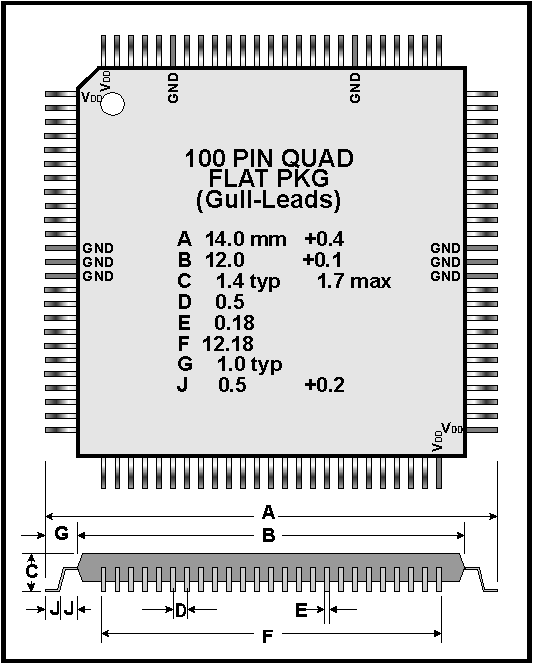
PCB Pad Pattern
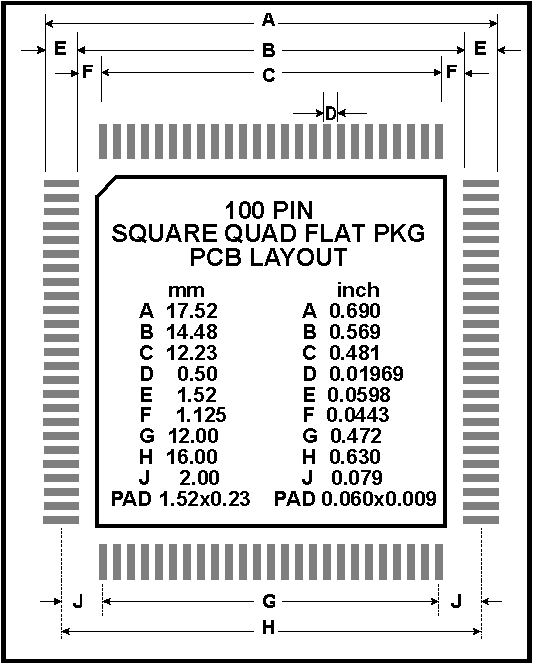
Electrical Specifications
Absolute Maximum Ratings
|
Ambient Temperature under
bias...................................................0°C to 70°C |
DC and Operating Characteristics
|
Temperature
Range........................................... 0°C to 70°C |
||||||
|
Sym |
Parameter |
Min |
Typ |
Max |
Unit |
Remarks |
|
Icc |
pwr supply current |
|
46 |
80 |
mA |
60 MHz |
|
|
20 |
40 |
mA |
40 MHz |
||
|
|
16 |
35 |
mA |
11 MHz |
||
|
Vih |
input high voltage |
2.0 |
|
5.5 |
V |
5 Volt tolerant inputs, |
|
Vil |
input low voltage |
-0.2 |
|
0.8 |
V |
TTL compatible |
|
Iih |
input high current |
-10 |
|
+10 |
uA |
Vin = Vdd |
|
Iil |
input low current |
-10 |
|
+10 |
uA |
Vin = GND |
|
Voh |
output high voltage |
2.4 |
|
|
V |
Ioh = -4 mA |
|
Vol |
output low voltage |
|
|
0.4 |
V |
Iol = 4 mA |
|
|
|
0.4 |
V |
Iol = 8 mA on IoChRdy |
||
|
Ioz |
Tri-state leakage current |
10 |
|
+10 |
uA |
Vin = GND to Vdd |
|
Ipu |
Pull-up current |
22 |
66 |
160 |
uA |
Vin = GND, R ~ 50K ohm |
|
Fcy |
crystal frequency |
4 |
|
51 |
MHz |
see clock circuits |
|
Fos |
oscillator frequency |
1 |
|
60 |
MHz |
see clock circuits |
Clock Circuits
The P-51 may operate with crystal or external clock circuits, as shown in the clock figures. An external oscillator in the range of 1 to 60 MHz may be used on XTAL1, and must use the same VDD voltage as the P-51.
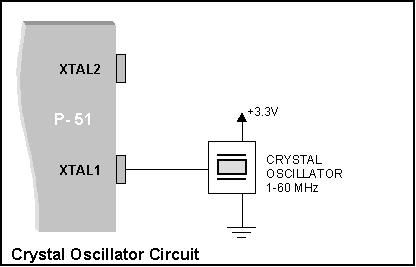
The frequency range for the crystal circuit is 4 to 51 MHz. The circuitry is slightly different for fundamental vs. third-overtone crystals. The boundary between fundamental and third overtone crystals is approximately 26 MHz and should be verified with the crystal manufacturer.
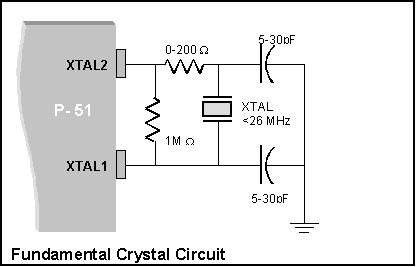
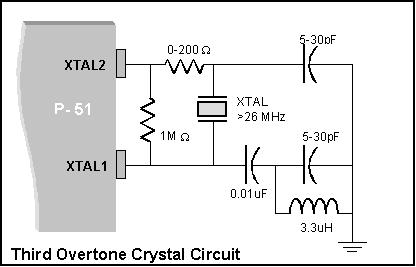
As with standard 8051 devices, the internal P-51 serial baud rates assume an 11.059 MHz crystal and multiples thereof.
P-51 Demo Circuit
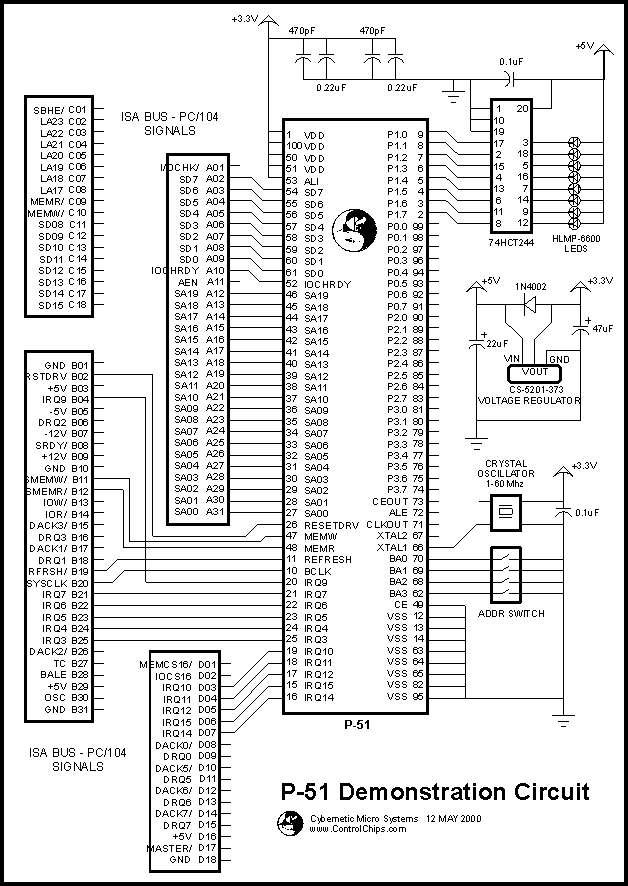
![[Logo]](gif/smlogo2.gif) Cybernetic Micro Systems
Cybernetic Micro Systems
![PRODUCTS [Products]](gif/barprod.png)
![PRICES [Prices]](gif/barprice.png)
![SALES [Sales]](gif/barsales.png)
![COMPANY [Company]](gif/barcorp.png)
![HOME [Home]](gif/barhome.png)
